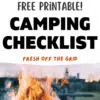Ultimate Camping Checklist
This post may contain affiliate links.
This car camping checklist will help you make sure that you have everything you need for your next camping adventure!
Whether you’re new to camping or a seasoned pro, this guide is for you. Not only do we cover all the “must-have” camping essentials, but we are also offering a printable PDF checklist as well as an interactive digital checklist (you can use these while you pack up your car!).
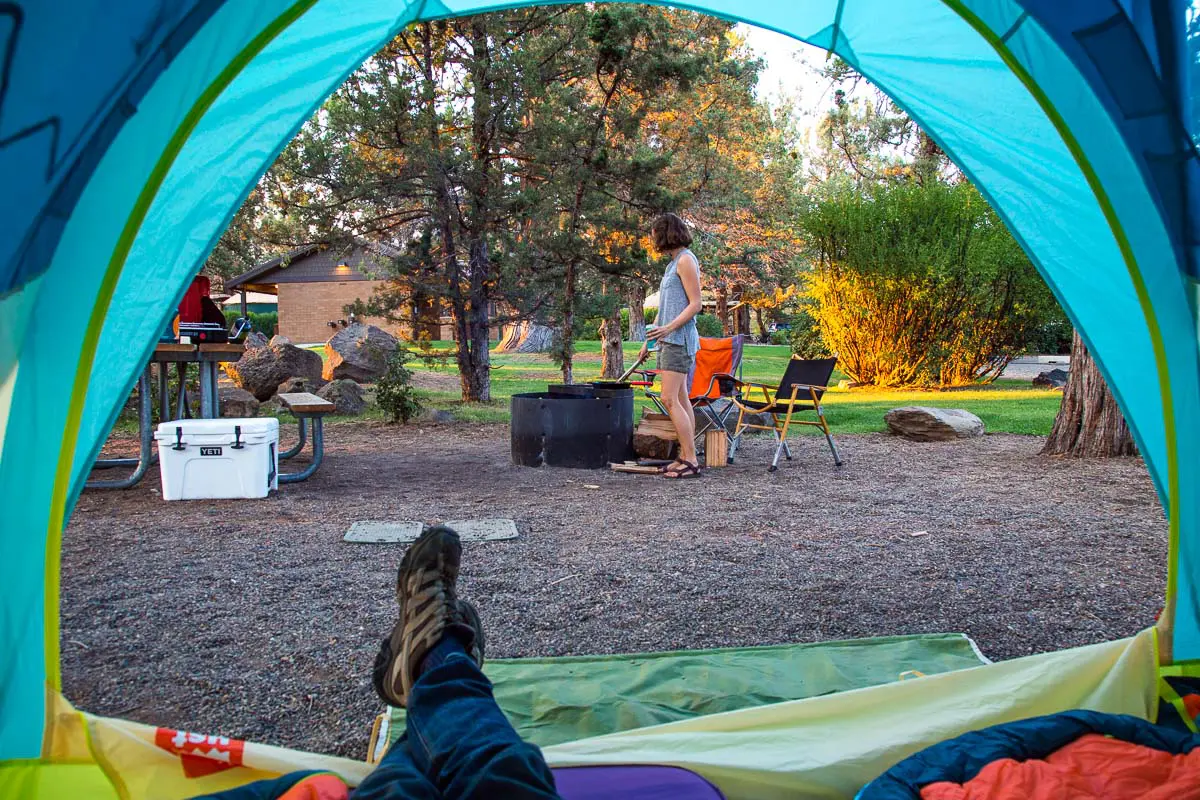
Car camping allows you to bring all the fun camping accessories that make your outdoor experience a LOT more comfortable. Cozy camping chairs, cast iron cookware, and a cooler full of ice-cold drinks!
However, all this stuff means there’s more to potentially forget…
Over the years, we have forgotten a lot of things. Everything from can openers to headlamps. Once we even forgot to bring our sleeping bags! (That was a long drive back home.) But with this checklist, we’re going to set you up for success.
Below are the camping essentials you will want to consider before your next camping trip.
This checklist and guide were written specifically for front-country car camping, where you drive right up to your campsite. If you are interested in campsites you need to hike to, we recommend checking out our backpacking checklist which features lighter-weight gear.
General Camping Packing Tips
- If space allows, store all your camping gear together in a dedicated area, or in clear storage bins. You don’t want to have to go hunting around the house/garage/shed to track everything down Friday afternoon.
- For small inexpensive items, consider buying a duplicate camping version for things like cooking utensils, can opener, silverware, etc. Second-hand stores can be great for this. This way your bottle opener is never left behind in the kitchen drawer at home.
- Use a checklist! A checklist can jog your memory while you pack and help you remember things you might have overlooked. It also provides a way to keep track of what you have already accounted for. One of the biggest improvements we have personally made is to start using our own checklist.
If you’re new to camping, we know this list might feel a bit overwhelming. Know that a lot of items can be brought from home (bedding, kitchen equipment) and you don’t have to run out and buy everything brand new.
Booking Your Campsite
Before you start packing up all your gear, you’ll want to know what type of amenities your campsite will offer. Bathrooms with showers? Fire pits? A dish washing station? When you book your site, make note of these things so you can add or subtract items from your camping checklist.
The Dyrt is a great place to research campsites—it’s like Yelp for campgrounds. You’ll be able to see what amenities the campground offers, see photos, and read other camper’s reviews. The website is free to use, but you can try a PRO membership for 30 days free here, which gives you additional features like offline maps and a road trip planner so you can plan out your trip from start to finish.
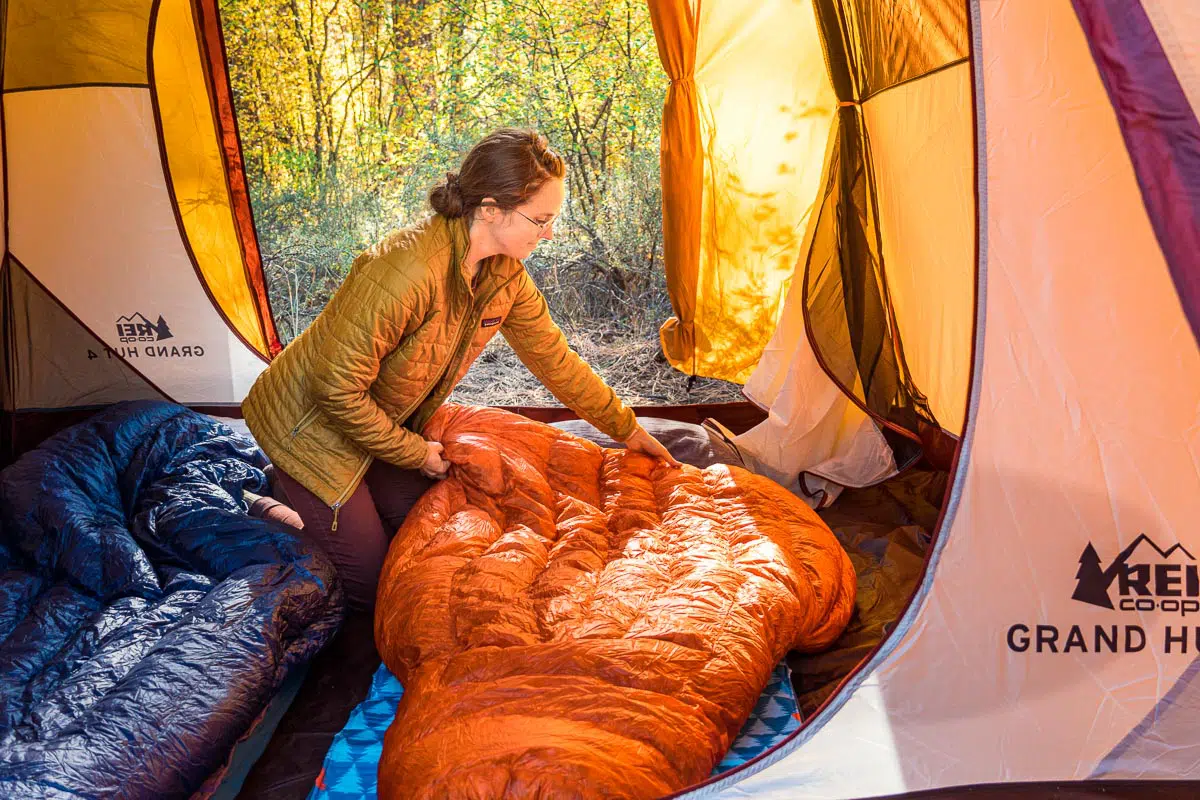
Shelter & Sleep System
A tent, sleeping bag, and sleeping mat together make up your sleep system. Forgetting one or both of these items has the potential to ruin your trip (which we know from experience!), so double-check your camping sleep system is in order before your trip.
✔️ Camping Tent
First things first: you’ll need a tent! A tent will protect you from wind, rain and morning dew, and insects. While there are some alternative shelters like hammocks and bivvies, for the vast majority of recreational campers, a tent is by far the most practical option.
Here are a few things to look out for when you’re buying a tent:
- Tent manufacturers tend to be a little optimistic about how many people will comfortably fit in their tents. Keep in mind that a 4 person tent will fit 4 people when their sleeping mattresses lay snugly next to each other—leaving little to no free space. If you want extra interior space or room for bags, size up.
- We HIGHLY recommend getting a free-standing for car camping. This means you don’t have to stake anything out or use guylines (though these things do help in windy conditions). Free-standing tents are generally easier to set up and if you need to reposition it, all you have to do is pick it up (instead of disassembling it and starting all over again!).
- Take a moment to watch any videos of the set-up to make sure it’s fairly easy, with the caveat that bigger tents will almost always be more complicated to set up than smaller tents.
- If you live in an area where you’re likely to encounter rain on your camping trips (hi fellow PNWers!) pay special attention to the weatherproofing features of the tent. Additionally, a decent-sized vestibule can be useful in wet conditions.
There are a TON of tent designs out there, but here are a few of our top picks to start with.
- Budget-Friendly 2 Person Tent: Coleman Skydome Tent ($90)
- Budget-Friendly 4 Person Tent: Kelty Discovery Basecamp 4 ($109.95)
- Family-Sized Tent: REI Wonderland 4 ($549)
- Camping-Backpacking Crossover Tent: REI Half Dome SL2 ($349) or Kelty Late Start 2 ($159)
✔️ Camping Mattresses
A camping mattress does two things: it provides both insulation and cushioning between you and the ground. You can choose between full, bed-style air mattresses, or individual inflated sleeping pads.
Hands down, our favorite sleeping pad is the UST Fillmatic. It’s THE most comfortable sleeping pad we’ve tried so far, provides an R-6 insulation value, and is budget-friendly.
If you want a bed-style air mattress, the Kingdom Insulated Air Bed provides 6 inches of padding for a comfy night’s sleep for two, or the ExPed Mega Mat Duo boasts an R-value of 10 if you frequently camp in colder conditions.
✔️ Sleeping bags or Bedding
Depending on the conditions, you will want to make sure you have either a sleeping bag or insulated bedding.
This can be as simple as bringing along sheets and a warm comforter from home (especially if all you do is warm-weather summer camping), or you can buy sleeping bags specifically for camping.
Here are a few things to look out for when you’re buying a sleeping bag:
- All sleeping bags come with a temperature rating. Generally, this rating tells you what the low limit of the bag is—which is not necessarily the same as a comfort rating.
- Down vs synthetic: Down is more expensive but warmer by weight than synthetic. Down bags also require special care when washing, but can last longer than synthetic bags when cared for correctly.
✔️ Pillows
Since many people use their bed pillows from home, they tend to get overlooked. So make sure you grab them by using our checklist –OR– buy a dedicated inflatable camping pillow that you just keep with all your camping stuff.
We own the Sea-To-Summit Aeros Ultralight and the Cocoon sleeping bag hood pillow for backpacking, but on car camping trips we bring our pillows from home (honestly, they are just more comfortable!).
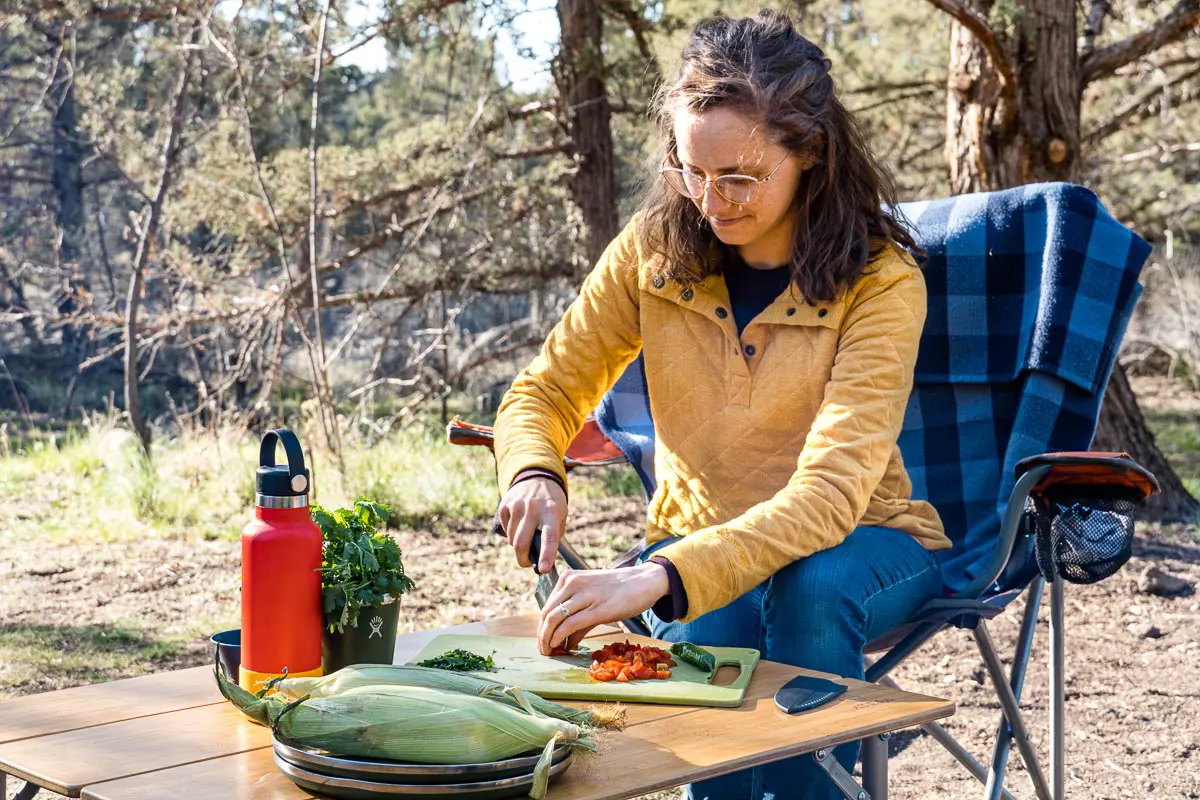
Campsite Essentials
✔️ Camp Chairs
Whether it rocks, reclines, has a built-in cooler, or is perfectly set up for snuggling, a comfy camp chair is a must at any campsite! Nothing ruins an evening around the campfire like sitting on a sap-filled stump or lumpy rock.
✔️ Camp table and tablecloth
Most developed campsites will provide a picnic table with benches, but if you plan on free camping or boondocking, you’ll likely need to bring your own.
We personally find that an extra camp table is nice to have even if there’s a picnic table at the site. Sometimes the picnic table isn’t ideally placed and too heavy to move, in which case a portable table is great because we can place it wherever is most convenient.
You may also want to bring a tablecloth, both for practical purposes and to make your site feel homier. A tablecloth can make it easier to clean up at the end of the night—just wipe it down with a sponge—and sometimes picnic tables are in less than ideal condition, in which case you’ll be happy to have a tablecloth to hide an unappealing surface!
✔️ Lighting
A small lantern is useful to have for hanging around camp after dark. The Black Diamond battery-operated Moji or the USB rechargeable reMoji lanterns can be hung overhead or placed on your picnic table.
For walking around camp or to the bathrooms, a headlamp can be helpful. The BioLite HeadLamp 200 is a USB-rechargeable headlamp that lasts up to 40 hours. This one is light enough that we bring it on our hiking and backpacking trips, too.
For a little campsite ambiance, a fun extra is a set of outdoor twinkle lights. We picked up a set for our campground wedding and they were SO magical that we have brought them on every camping trip since. These ones are perfect because they are solar-powered—no outlet necessary!
✔️ Sunshade/rain shelter
If you expect any rain, or if it’s going to be sunny and hot and you’re camping in an area with limited tree coverage, a sunshade or rain shelter can make your camping experience much more comfortable.
- Roof Rack Awning: Yakima Slim Shady Roof Awning
- Tailgate Awning: Kelty Waypoint Tarp
- Shade & Rain Shelter: Caddis Rapid Shelter
- Shade and Bug Protection: Coleman Skyshade Dome
✔️ Rug or doormat
Setting up a doormat in the entryway of your tent gives you a place to dust off and remove your shoes, so you can reduce the amount of dirt you track into your tent. We like knowing that when we crawl into our sleeping bags at night, we’re not cuddling up to a bunch of dirt and small rocks!
✔️ Blankets
It’s an age-old camper dilemma: how do you keep your back from getting cold while your front is warm and toasty from the campfire? A camping blanket, of course!
Any old blanket will do, but we like to have dedicated blankets that we take camping so we don’t have to worry about campfire smoke infiltrating our house when we get back. These blankets stay in our camping bins in the garage.
This REI Camp Blanket looks wonderfully cozy, but if you want to really bundle yourself with warmth the REI Camp Wrap is the way to go!
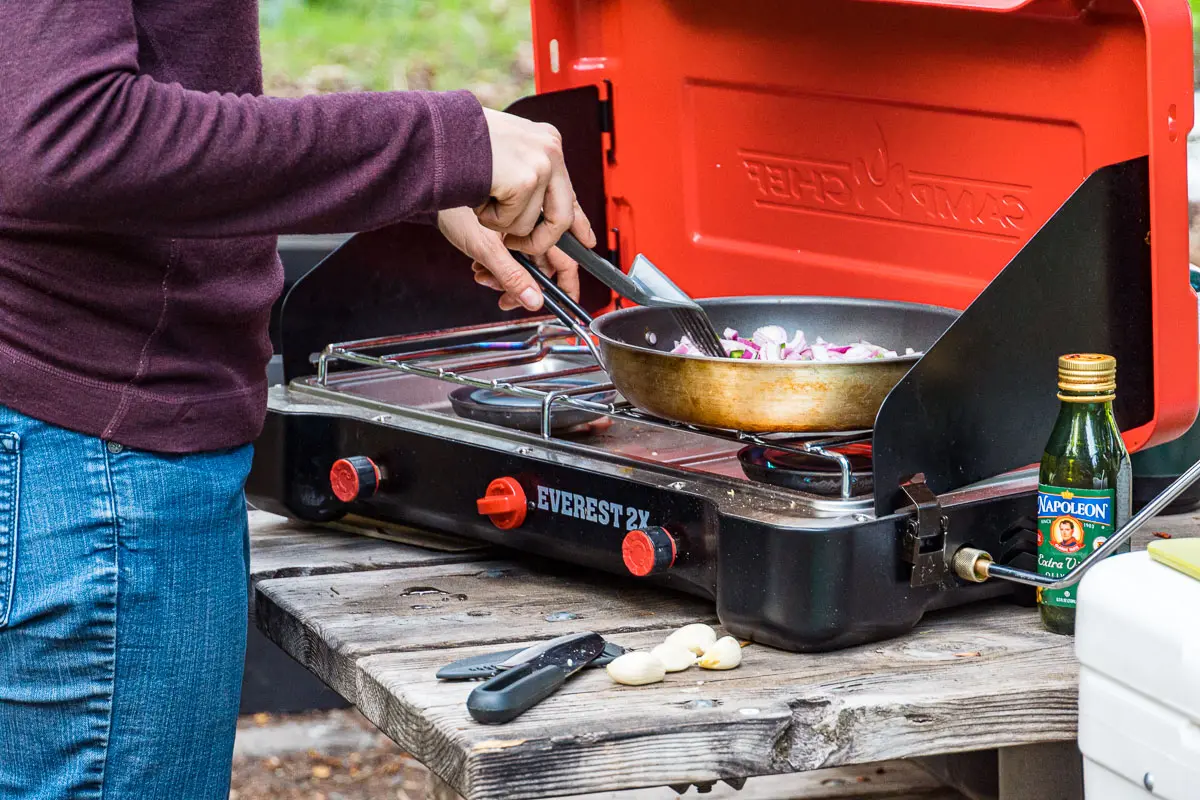
Camp Kitchen & Food
There are so many ways to set up your camp kitchen! If you are interested in taking a deep dive, check out our Ultimate camp kitchen guide. Below we cover what we consider to be camp kitchen essentials.
✔️ Camp Stove & Fuel
A camp stove is your ticket to delicious “home-cooked” meals at the campsite.
We have an entire guide to choosing the best camping stove if you want to learn more, but our top recommendation for a high-quality two-burner camping stove is the Camp Chef Everest. We’ve used this stove for years and it has great simmer control and wind resistance, and is easy to clean.
If you camp frequently, consider investing in a reusable propane tank to cut down on single-use green gas canisters. This 4.5L Ignik Gas Growler will ensure you have plenty of fuel for your trip (it lasts 4x as long as the green canisters)—without the waste!
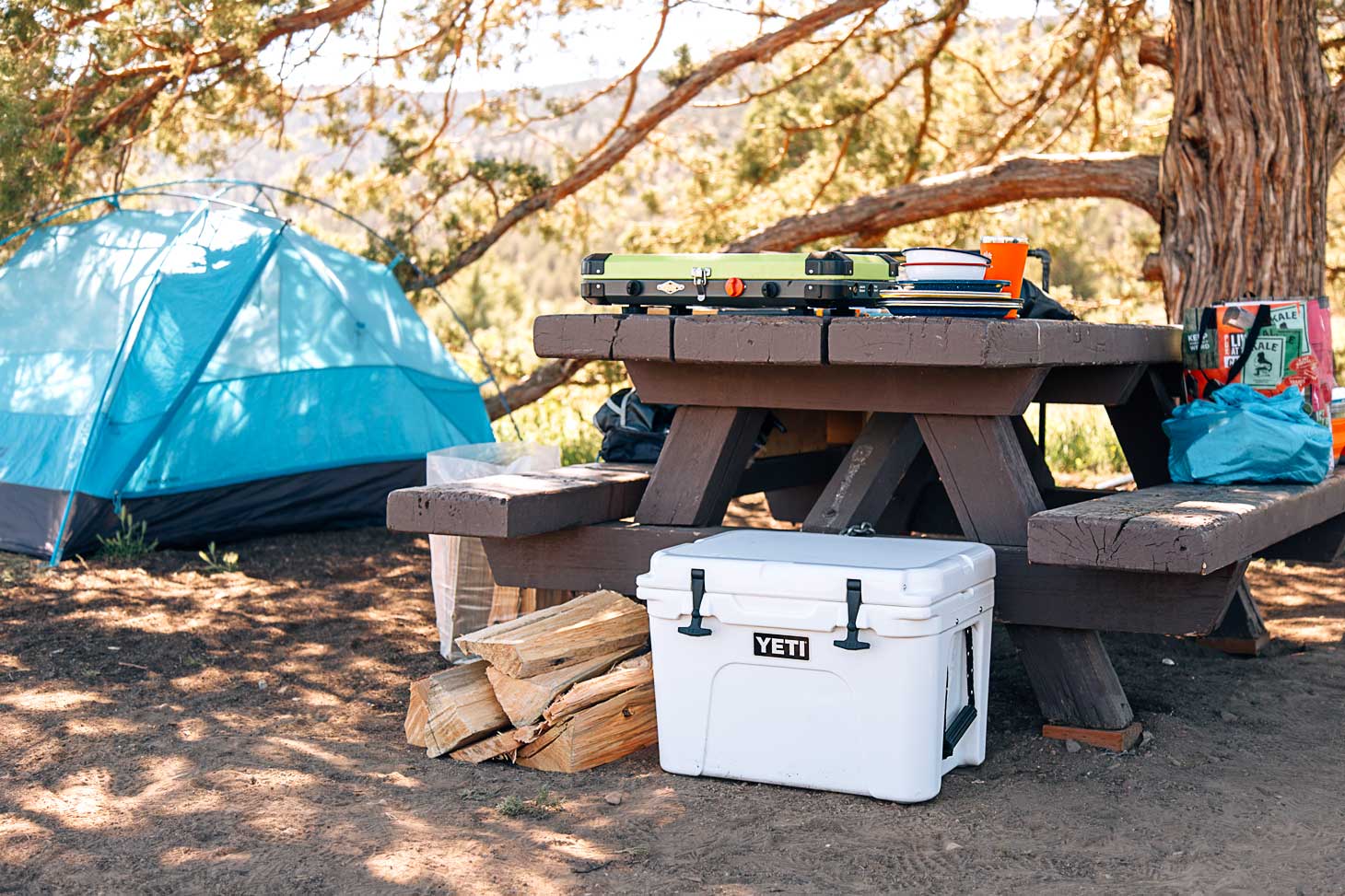
✔️ Cooler
A quality cooler is key to bringing fresh ingredients to your campsite and keeping perishable items food-safe.
If you’re just starting out or are on a budget, we’ll warn you that there can be some serious sticker shock when it comes to buying a cooler. BUT, you don’t have to drop hundreds of dollars—half the battle is simply knowing how to pack a cooler properly.
You can get by with a lower price point cooler if you pack it properly—especially if you’re only camping for a weekend.
- Budget-friendly cooler: Igloo EcoCool
- Reasonably priced roto-molded cooler: RTIC Cooler
- Price is no object: YETI Tundra
✔️ Water jug
Having a refillable water jug at your campsite is so convenient. Fill it up and you have readily available water for filling bottles, cooking, and cleaning up right at your site, so you don’t spend the evening walking back and forth to the communal water spigot.
- Soft-Sided Water Storage: Sea to Summit Watercell X
- Hard Sided Water Storage: Scepter Water Container
- Water Storage with Build In Purification: HydroBlu Pressurized Jerry Can
✔️ Pots and Skillets
Take a moment before your trip to plan out your meals and make a list of how many pots and skillets you’ll need. If you’re cooking simple meals, a large pot and one skillet may be all you need! Below is some of the camp cookware we might bring with us, depending on what we’re cooking.
- 10” or 12” Cast Iron Skillet
- Sea-To-Summit Alpha Pot
- 10” GSI Bugaboo Non-Stick Skillet
- Stanley Even-Heat Pro Set
✔️ Knives and cutting boards
When prepping ingredients at camp, we’re big believers in using a full-sized, fixed-blade chef knife. We just feel it fits in our hands better and offers more control than a small fold-out blade. You can bring yours from home or pick up a dedicated camping knife, so you don’t ever leave it behind.
This knife is great because it comes with a protective, locking sheath. Not only does this make storing much safer, but it protects the blade from dulling.
✔️ Cooking Utensils
Some of these you might want to bring from home, some you might want to buy dedicated camping versions of so they are always in your kitchen bin.
- Spatula
- Tongs
- Large spoon
- Ladle
- Whisk
- Strainer
- Cheese grater or microplane
- Can opener
- Bottle opener / corkscrew
- Measuring cups
- Pot holder
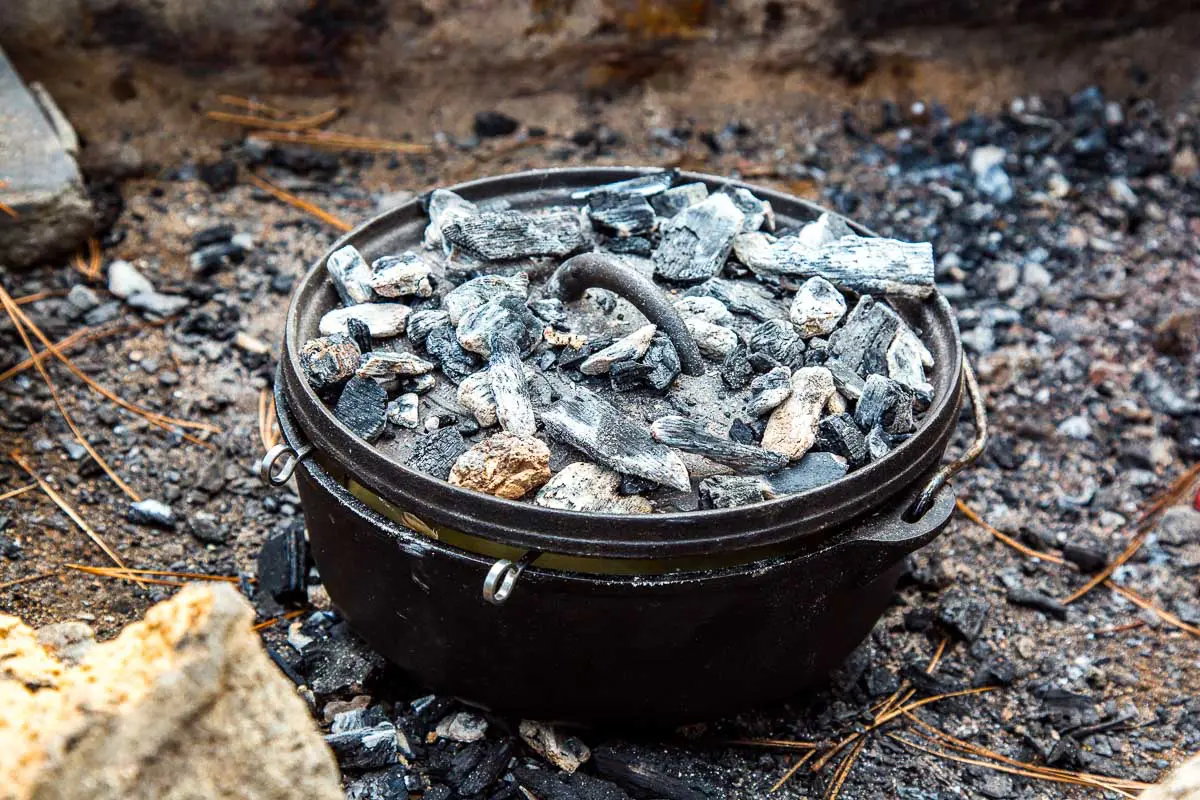
✔️ Camp Cooking Extras
Your menu might call for some more specialized cooking gear, so add these to your camping checklist as needed:
Dutch oven
One of the most versatile pieces of camping cookware, a Dutch oven opens up a ton of cooking opportunities: you can saute, braise, steam, boil, and bake.
Pie iron
Using a pie iron is such a fun way to cook over the fire! Make yourself a cheese sandwich or a pie iron pizza pocket.
Griddle
A good cast iron griddle can be used over a two-burner stove or a campfire, allowing you much more cooking space.
Instant read thermometer
Camp cooking tends to be a little more variable than cooking at home, so if you plan on cooking meat, an instant-read thermometer is helpful to make sure your meat is cooked properly. We find this to be especially helpful when cooking over a campfire.
Foil + Parchment Paper
If you’re big into foil-packet meals, then you are going to want to make sure you have some aluminum foil and parchment paper.
Skewers
If you’re making kabobs, we highly recommend getting a set of flat metal skewers, which will prevent your food from spinning on the stick and can be reused for years.
Roasting sticks
If s’mores are on the menu, then you will want to bring roasting sticks! Don’t hack up a nearby sapling.
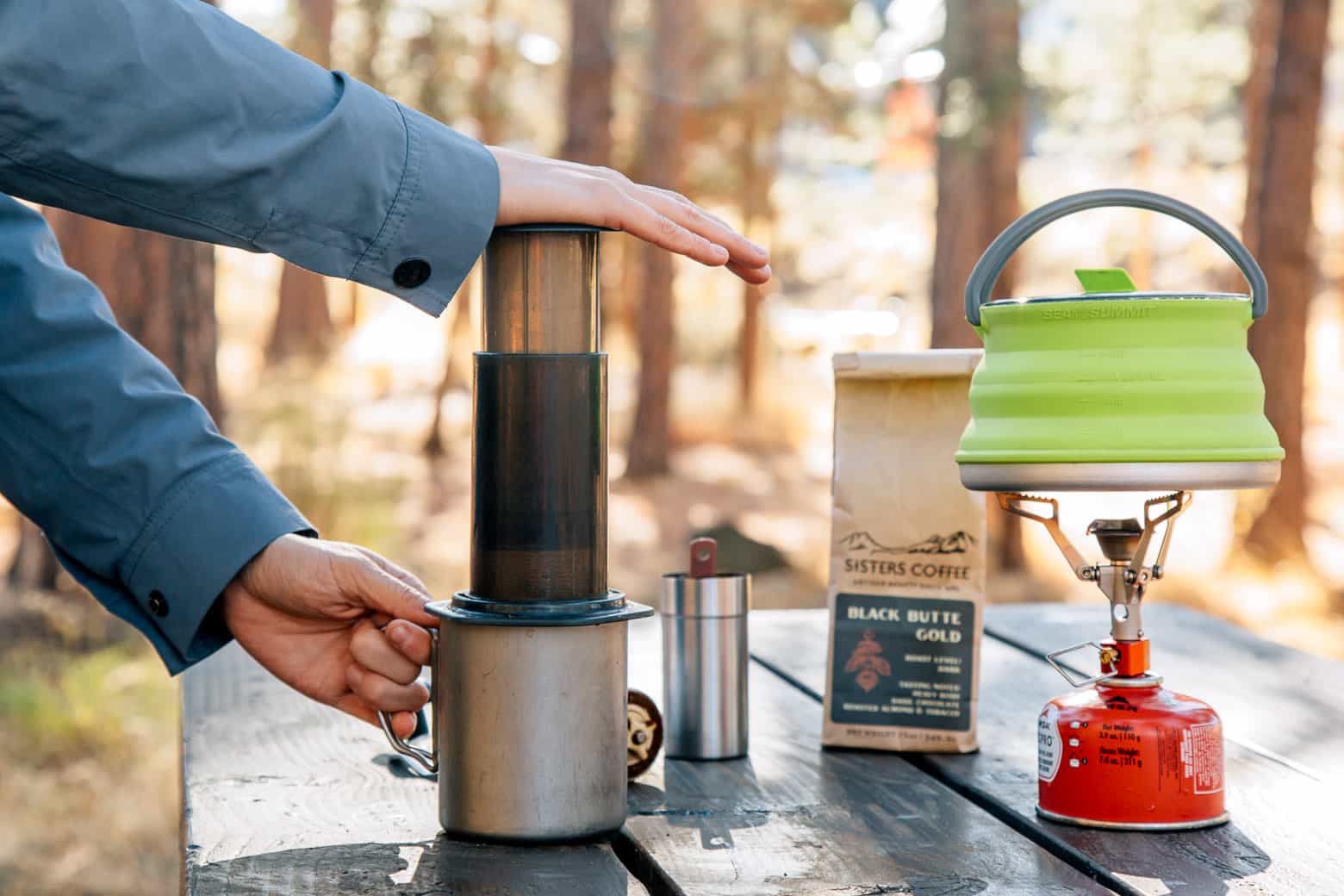
✔️ Camping Coffee Maker
There’s really nothing better than a slow morning in camp with a hot cup of coffee in hand. We’ve written extensively about camping coffee makers, but for 1-2 people our favorite method by far is the Aeropress. For groups, we’d recommend a stove-top percolator.
✔️ Serving and Tableware
You’ll want to pack a set of the essentials for each person: a plate, bowl, cup, and utensils. And of course, you’ll need some serving spoons and tongs for dishing up your meal!
Choose tableware that is sturdy and unlikely to break when it’s rattling around your camp box (definitely leave anything glass at home!). These enamelware pieces from Barebones are super classy and durable.
For drinkware, it doesn’t get better than Hydro Flask’s tumblers. They come in a variety of sizes and do an excellent job of keeping your hot drinks hot and cold drinks cold.
✔️ Containers for leftovers
Leftovers can be great for quick lunches or added to the next night’s dinner (chili mac baked potatoes, anyone? 😋). Bring a few tupperware containers so you can store your leftovers in the cooler instead of having to over serve yourself or dump things in the trash.
✔️ Camping Food
Last but not least, you’ll want to plan a great camping menu so that you have lots of great meals to look forward to on your trip. Here are collections of some of our favorite recipes on the site to get you inspired:
- 18 Camping Breakfasts
- 27 Easy Camping Meals
- 23 Foolproof Camping Recipes
- 52 One Pot Camping Meals
- 29 Dutch Oven Recipes
- 11 Camping Desserts
- browse our entire camping recipe index
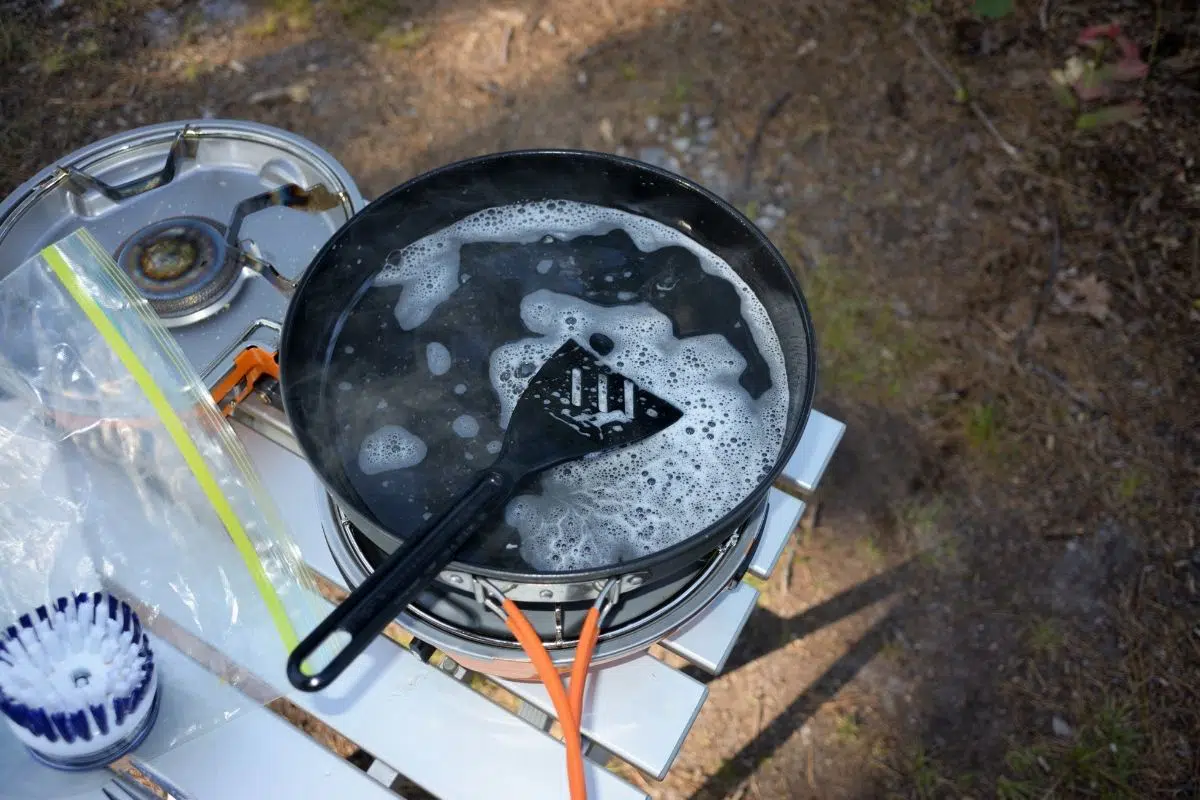
Cleanup
While washing the dishes is not the most popular camping activity, it is a necessary one. And having the right equipment can make the job a lot easier.
✔️ Sink
Bringing along a large basin (or two) will give you a lot of room and makes washing larger items like plates and cookware much easier. These collapsible sinks are sturdy and easy to pack.
✔️ Soap
Make sure you’re using biodegradable soap whenever you’re camping. A small bottle of unscented Dr. Bronner’s is our go-to.
✔️ Quick dry towels
While air-drying your dishes is preferable, having a quick-dry towel on hand is helpful in case dishes aren’t 100% dry when you have to put them away.
✔️ Trash bags/bin
One of our biggest camp kitchen improvements was purchasing a self-standing, collapsible trash can with a zipper top lid—no more hanging a garbage bag from a tree branch! Move it to where it’s convenient while keeping the bugs and critters out.
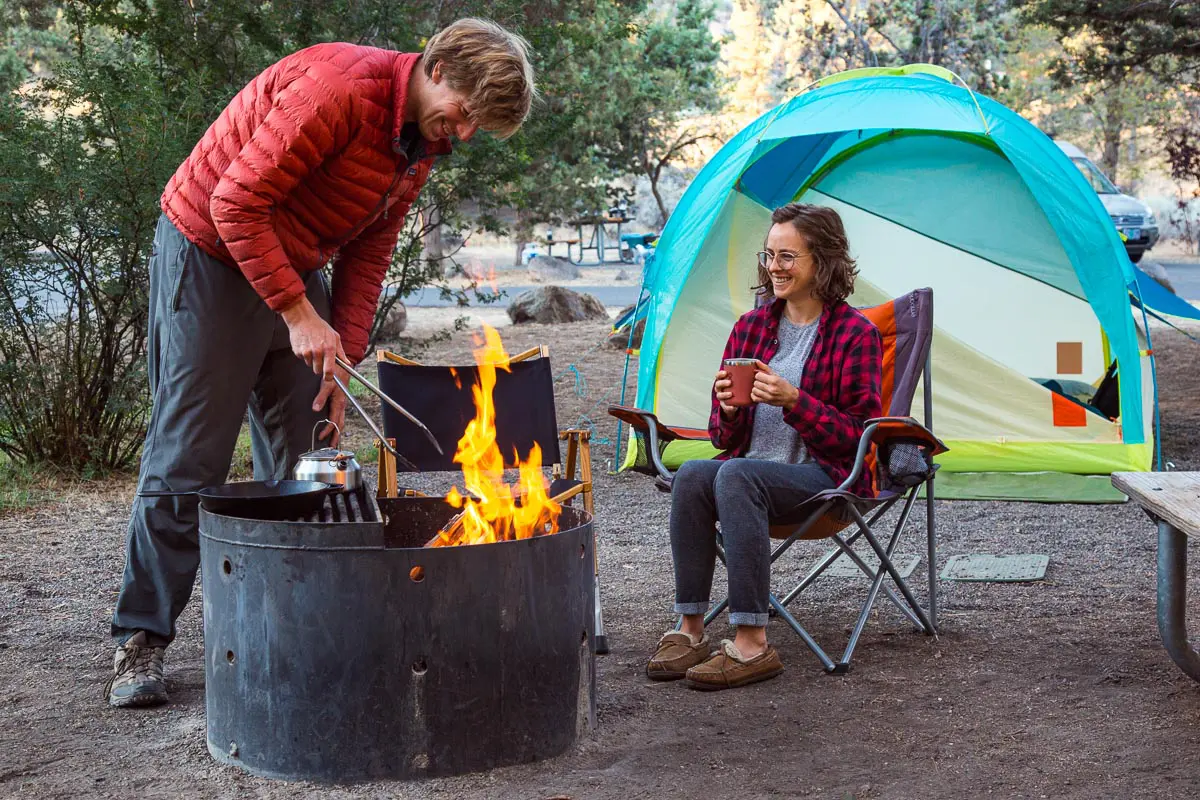
Campfire Tools
If you are planning on having a campfire, here are a few pieces of equipment you might want to add to your camping checklist.
- Hatchet: Even if you’re using a substantial firestarter, you will still need to break apart those full logs into smaller, more manageable pieces. We’re big fans of this small Fisker hatchet.
- Grill Grate: While most campgrounds have campfires with grates, their condition can be less than appealing. This portable grill can be placed on top of the campground grill grate (with the legs collapsed) or used on its own (when free-standing).
- Collapsible Chimney: This collapsible chimney starter can get your coals going in minutes without the use of noxious-smelling lighter fluid.
- Grill gloves: We highly recommend picking up a pair of heat-resistant gloves. These make campfire cooking a little safer so you can pick up cast iron skillets, turn kabobs, move coals around on your Dutch oven lid, and adjust your campfire grill grate.
- Bucket & shovel: The ability to rapidly extinguish your fire if things get out of control is an essential safety concern. That’s why it’s recommended to always have a 5 gallon bucket full of water and a small shovel on hand.
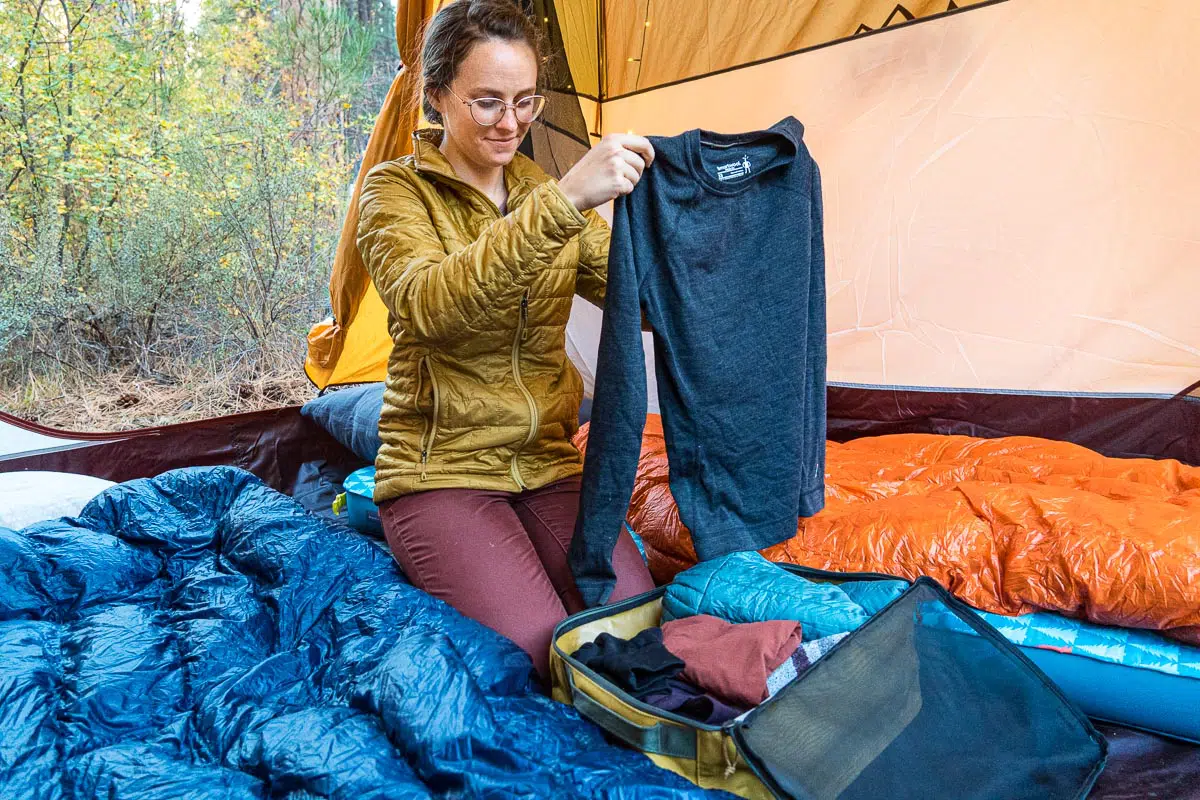
Camping Clothes List
This section of your camping packing list will be largely determined by the season, weather, and environment you’re camping in. Take some time to look up the weather forecast and think about the types of activities you’ll be doing and then build your wardrobe from there. Having layers is always a good bet, too! Here is a basic packing list to get you started:
- Short-sleeved shirts or tanks
- Long sleeved shirt
- Pants and shorts
- Underwear
- Socks
- Sturdy shoes and/or hiking boots
- Camp sandals or slippers
- Lightweight jacket or windbreaker
- Warm/insulated jacket
- Base layers or long underwear (for cooler trips)
- Rain gear
- Sun hat or baseball cap
- Warm beanie
- Gloves or mittens
- Sunglasses
- Bathing suit + water shoes (optional)
- Any other activity-specific clothing items
Safety, Hygiene, and Toiletries
When going through this portion of your camping packing list, keep a few things in mind: what facilities does your campsite provide? If there are no showers, for example, you might want to add a sun/solar shower to your list. If you’re dispersed camping with no bathrooms, you will need to plan for that.
✔️ Toiletries
Travel sizes work best for packing into bins. You can make your own travel-sized versions of some of your favorite products using refillable squeeze containers like GoToobs. Here’s a quick list of the basics:
- Toothbrush
- Toothpaste
- Floss
- Lip balm
- Sunscreen
- Insect repellant
- Deodorant
- Lotion
- Hand soap or hand sanitizer
- Shower supplies (shampoo, etc)
- Shower shoes
- Medications
- Trowel (optional, if dispersed camping) and toilet paper
✔️ First aid kit
Bring along a first aid kit with items like bandaids, wound cleaning and treatment, sterile gauze and pads, OTC medications like ibuprofen or Tylenol, Imodium, and antihistamines. You can buy a pre-assembled kit like one of these, or check out this comprehensive list to guide you through building your own DIY kit.
As part of your first aid kit, take a moment while you’re at home to look up the nearest urgent care and/or hospital to your campsite just in case you need it and your site doesn’t have cell service.
✔️ Gear repair kit
Keeping a few gear repair items in your camp box can really come in handy if your air mattress or tent springs a leak! Recently we had to abandon a camping trip because we did NOT take our own advice and had no way of patching a hole we discovered in our tent during a rainstorm. Here are a few things to keep on hand:
- Tenacious Tape gear repair tape
- Tenacious Tape patches
- Sil-nylon Patches
- Flex Patches (good for sleeping mats)
- Tear-Aid Tape for Vinyl
- Seam Sealer (for sil-nylon / for synthetics)
- Tent pole splint
- Extra stakes and guylines
✔️ Clothesline and clips
This is an extra, but a clothesline and some clips are nice to have to dry out towels, dishcloths, and clothes. We think it’s especially handy for families with young kids.
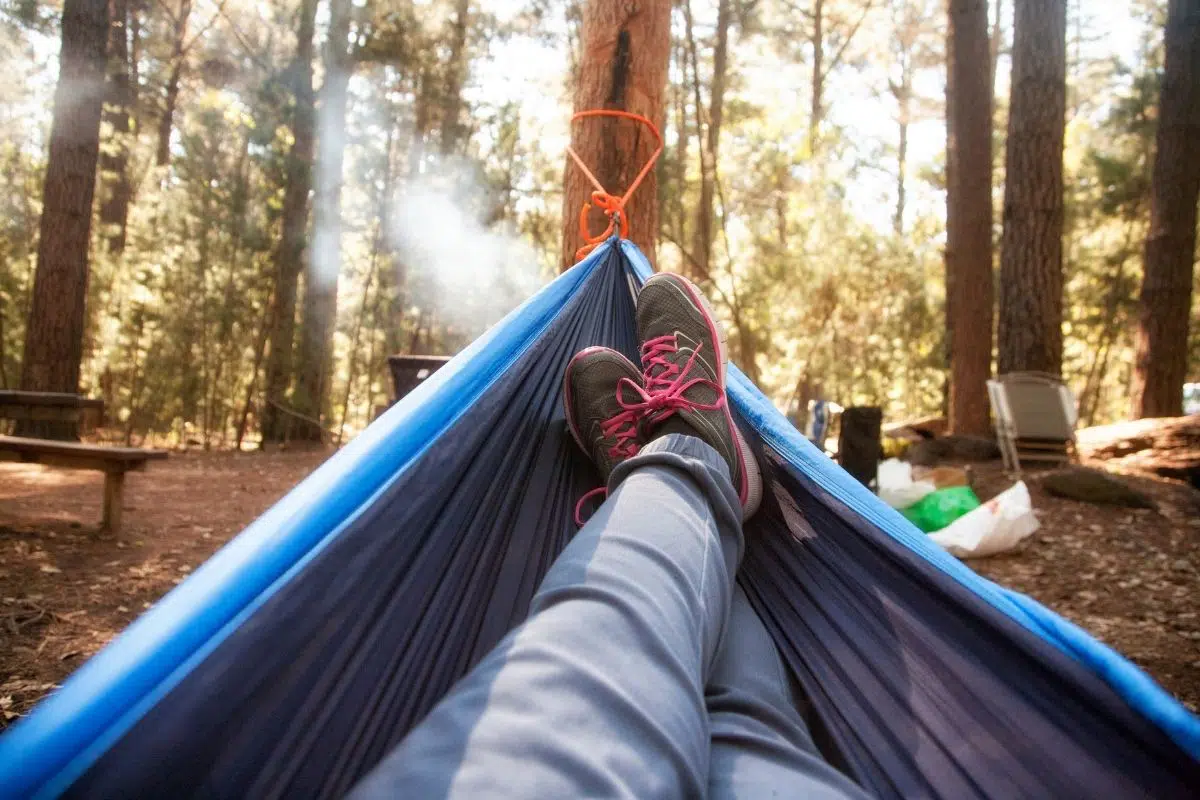
Extras and camping activities
This section is totally up to you! What do you love to do while camping? Perhaps you want to chill in a hammock and read a book, play guitar around the campfire, go on day hikes, hang out by a river or lake, or ride bikes and scooters with the kids. Be sure to include items for all your fun and relaxing activities on your personal camping checklist.
- Camera, battery, memory card
- Charger cord/battery bank
- Hammock
- Book/Kindle
- Journal & pen/pencil
- Guitar or other instruments
- Small portable speaker
- Kid’s toys and activities
- Bikes or scooters & helmets
- Water toys & lifejackets
- Hiking daypack and 10 essentials
- Field guides for hikes, plant/animal identification, etc.
- Anything else you love to do while camping!

Camping gear organization
Having a system to keep all your camping gear organized makes packing for your trip and your life in camp so much easier. Here are a few strategies we personally employ that we personally employ with our supplies.
✔️ Storage boxes and bins
Nearly all of our camping gear fits into a few Action Packer boxes. These stack neatly on shelves in our garage. When we pack up for a trip, we just have to confirm everything is in there, and then move the whole box to the trunk of the car.
While at camp, the bins help us from having a gear explosion all over the campsite, while keeping curious critters out and helping to keep things clean(er). We keep bins with kitchen gear, our camping pantry, and other campsite essentials.
✔️ Camp Kitchen Organization
If you’re going to bring a table with you, you could consider one that includes a kitchen organizer like this one to give you space to store pots, pans, and dishware between meals. A small utensil caddy can help keep your picnic table organized and looking tidy.
✔️ Packing cubes
Packing cubes are a great way to keep all your clothes organized in your duffel bag. We use a couple to group clothes together by type (shirts, bottoms, socks & underwear, etc) but you could also pack your clothes by day so all you have to do is grab one cube each morning.
Ultimate Camping Checklist
Use this camping pack list to help you get organized for your next trip. If you want a printable camping checklist, sign up for our email list and we will send you one for free!
Camping Packing List
Tent, stakes, and rain fly
Sleeping bags
Sleeping pads
Pillows
Bedding (sheets, blankets), optional
Mattress pump, optional
Lantern / headlamps / string lights
Camp chairs
Camp table + tablecloth, optional
Sun shade / rain shelter, optional
Rug or doormat for tent entry
Camp Kitchen
Camping stove read more
Stove fuel
Lighter or matches
Cooler read more
Water jug
Coffee maker
Skillet/frying pan
Cook pot with lid
Pot holder or heat proof gloves
Griddle, optional
Portable grill grate, optional
Cooking utensils (spoon, tongs, spatula…)
Sharp knife
Cutting board
Mixing bowls, optional
Measuring cups/spoons, optional
Can opener
Bottle opener / corkscrew
Dutch oven, optional
Heavy-duty foil / parchment paper, optional
Skewers / roasting sticks, optional
Pie iron, optional
Containers for leftovers
Organization / storage bins
Serving
Plates
Bowls
Forks, spoons, and knives
Napkins
Drinking glasses
Coffee mugs
Water bottles
Cleanup
Dish basin / sink
Biodegradable soap
Sponge
Srubber
Cast iron scraper
Microfiber dish towel
Paper towels
Dish drying rack, optional
Trash can / trash bags
Short sleeved shirts / tanks
Long sleeve shirt
Pants and shorts
Underwear
Socks
Sturdy shoes and/or hiking boots
Camp sandals or slippers
Lightweight jacket
Warm / insulating jacket
Base layers / long underwear
Rain gear
Sun hat or baseball cap
Warm beanie
Gloves / mittens
Bathing suit & water shoes, optional
Sunglasses
Other items for activities
Toiletries, Safety, and Hygiene
First aid kit
Gear repair kit
Knife / multitool
Thooth brushes
Toothpaste
Floss
Medications
Lip balm
Sunscreen
Insect repellant
Deodorant
Lotion
Soap
Hand sanitizer
Shower supplies
Quarters for the shower, optional
Shower shoes, if needed
Quick dry bath towels
Camp shower, optional
Trowel & TP, if dispersed camping
Campfire Tools (optional)
Check current fire regulations in the area
Firewood (purchased near campsite)
Firestarter / kindling
Lighter / matches / propane torch head
Hatchet
Charcoal & chimney starter
Water bucket for dousing fire + small shovel
Extras/Misc.
Photo ID, credit card, case, printed site reservations
Phone
Camera w/ battery & memory card
Charging cables / battery bank
Hammock
Book / Kindle
Journal & pen/pencil
Instrument
Kid’s toys or activities
Bikes or scooters & helmets
Water toys & lifejackets
Hiking daypack
Other items for activities


